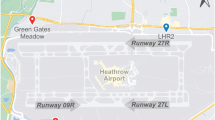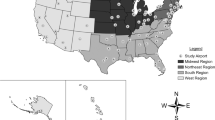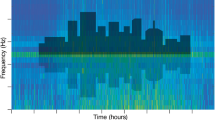Abstract
Objective
To measure sound levels in the aircraft cabin during different phases of flight.
Methods
Sound level was measured on 200 flights, representing six aircraft groups using continuous monitors. A linear mixed-effects model with random intercept was used to test for significant differences in mean sound level by aircraft model and across each flight phase as well as by flight phase, airplane type, measurement location and proximity to engine noise.
Results
Mean sound levels across all flight phases and aircraft groups ranged from 37.6 to >110 dB(A) with a median of 83.5 dB(A). Significant differences in noise levels were also observed based on proximity to the engines and between aircraft with fuselage- and wing mounted engines. Nine flights (4.5%) exceeded the recommended 8-h TWA exposure limit of 85 dB(A) by the NIOSH and ACGIH approach, three flights (1.5%) exceeded the 8-h TWA action level of 85 dB(A) by the OSHA approach, and none of the flights exceeded the 8-h TWA action level of 90 dB(A) by the OSHA PEL approach.
Conclusions
Additional characterization studies, including personal noise dosimetry, are necessary to document accurate occupational exposures in the aircraft cabin environment and identify appropriate response actions. FAA should consider applying the more health-protective NIOSH/ACGIH occupational noise recommendations to the aircraft cabin environment.
This is a preview of subscription content, access via your institution
Access options
Subscribe to this journal
Receive 6 print issues and online access
$259.00 per year
only $43.17 per issue
Buy this article
- Purchase on Springer Link
- Instant access to full article PDF
Prices may be subject to local taxes which are calculated during checkout


Similar content being viewed by others
References
National Institute for Occupational Safety and Health. Criteria for a recommended standard: occupational noise exposure revised criteria. U.S. Department of Health and Human Resources. Cincinnati, OH; 1998.
Basner M, Babisch W, Davis A, Brink M, Clark C, Janssen S, Stansfeld S. Auditory and non-auditory effects of noise on health. The Lancet. 2013. https://doi.org/10.1016/S0140-6736(13)61613-X.
Girard S, Leroux T, Courteau M, Picard M, Turcotte F, Richer O. Occupational noise exposure and noise-induced hearing loss are associated with work-related injuries leading to admission to hospital. Inj Prev. 2014;0:1–5.
Cordeiro R, Clemente APG, Diniz CS, Dias A. Occupational noise as a risk factor for work-related injuries. Rev Saúde Pública. 2005;39:1–5.
Concha-Barrientos M, Campbell-Lendrum D, Steenland K. Occupational noise: assessing the burden of disease from work-related hearing impairment at national and local levels. Geneva: World Health Organization; 2004.
Münzel T, Gori T, Babisch W, Basner M. Cardiovascular effects of environmental noise exposure. Eur Heart J. 2014;35:829–36.
Kraus U, Schneider A, Breitner S, Hampel R, Rückerl R, Pitz M, Geruschkat U, Belcredi P, Radon K, Peters A. Individual daytime noise exposure during routine activities and heart rate variability in adults: a repeated measures study. Environ Health Perspect. 2013;121:607–12.
National Research Council. ACRP synthesis 9: effects of aircraft noise: research update on selected topics. Washington, DC: The National Academies Press; 2008.
Franssen E, van Wiechen C, Nagelkerke N, Lebret E. Aircraft noise around a large international airport and its impact on general health and medication use. J Occup Environ Med. 2004;61:405–13.
Hygge S, Evans GW, Bullinger M. A prospective study of some effects of aircraft noise on cognitive performance in schoolchildren. Psychol Sci. 2002;13:469–74.
Evans GW, Bullinger M, Hygge S. Chronic noise exposure and physiological response: a prospective study of children living under environmental stress. Psychol Sci. 1998;9:75–77.
Floud S, Blangiardo M, Clark C, de Hoogh K, Babisch W, Houthuijs D, Swart W, Pershagen G, Katsouyanni K, Velonakis M, Vigna-Taglianti F, Cadum E, Hansell AL. Exposure to aircraft and road traffic noise and associations with heart disease and stroke in six European countries: a cross-sectional study. Environ Health. 2013;12:89.
Hansell AL, Blangiardo M, Fortunato L, Floud S, de Hoogh K, Fecht D, Ghosh RE, Laszlo HE, Pearson C, Beale L, Beevers S, Gulliver J, Best N, Richardson S, Elliott P. Aircraft noise and cardiovascular disease near Heathrow airport in London: small area study. Brit Med J. 2013;347:f5432.
Bluhm G, Eriksson C. Cardiovascular effects of environmental noise: research in Sweden. Noise Health. 2011;13:212–6.
Stansfeld S, Crombie R. Cardiovascular effects of environmental noise: research in the United Kingdom. Noise Health. 2011;13:229–33.
Eriksson C, Rosenlund M, Pershagen G, Hilding A, Őstenson C, Bluhm G. Aircraft noise and incidence of hypertension. Environ Res. 2010;110:764–72.
Huss A, Spoerri A, Egger M, Röösli M. Aircraft noise, air pollution, and mortality from myocardial infarction. Epidemiology . 2010;21:829–36.
Babisch W, van Kamp I. Exposure-response relationship of the association between aircraft noise and the risk of hypertension. Noise Health. 2009;11:161–8.
Selander J, Bluhm G, Theorell T, Pershagen G, Babisch W, Seiffert I, Houthuijs D, Breugelmans O, Vigna-Taglianti F, Antoniotti MC, Velonakis E, Davou E, Dudley M, Järup L. Saliva cortisol and exposure to aircraft noise in six European countries. Environ Health Perspect. 2009;117:1713–7.
Haralabidis AS, Dimakopoulou K, Vigna-Taglianti F, Giampaolo M, Borgini A, Dudley M, Pershagen G, Bluhm G, Houthuijs D, Babisch W, Velonakis M, Katsouyanni K, Jarup L. Acute effects of night-time noise exposure on blood pressure in populations living near airports. Eur Heart J. 2008;29:658–64.
Jarup L, Babisch W, Houthuijs D, Pershagen G, Katsouyanni K, Cadum E, Dudley M, Savigny P, Seiffert I, Swart W, Breugelmans O, Bluhm G, Selander J, Haralabidis A, Dimakopoulou K, Sourtzi P, Velonakis M, Vigna-Taglianti F. Hypertension and exposure to noise near airports: the HYENA study. Environ Health Perspect. 2008;116:329–33.
Rosenlund M, Berglind N, Pershagen G, Järup L, Bluhm G. Increased prevalence of hypertension in a population exposed to aircraft noise. Occup Environ Med. 2001;58:769–73.
Correia AW, Peters JL, Levy JI, Melly S, Dominici F. Residential exposure to aircraft noise and hospital admissions for cardiovascular diseases: multi-airport retrospective study. Brit Med J. 2013;347:f5561.
Orsello CA, Moore JE, Reese C. Sensorineural hearing loss incidence among U.S. military aviators between 1997 and 2011. Aviat Space Environ Med. 2013;84:975–9.
McReynolds MC. Noise-induced hearing loss. Air Med J. 2005;24:73–78.
Begault DR, Wenzel EM, Tran LL, Anderson MR. Survey of commercial airline pilots’ hearing loss. Percept Mot Skill. 1998;86:258.
Wagstaff AS, Årva P. Hearing loss in civilian airline and helicopter pilots compared to air traffic control personnel. Aviat Space Environ Med. 2009;80:857–61.
Tomei F, De Sio S, Tomao E, Anzelmo V, Boccolo TP, Ciarrocca M, Cherubini E, Valentini V, Capozzella A, Rosati MV. Occupational exposure to noise and hypertension in pilots. Int J Environ Health Res. 2005;15:99–106.
Haskell B. Association of aircraft noise stress to periodontal disease in aircrew members. Aviat Space Environ Med. 1975;46:1041–3.
McNeely E, Gale S, Tager I, Kincl L, Bradley J, Coull B, Hecker S. The self-reported health of U.S. flight attendants compared to the general population. Environ Health. 2014;13:13.
National Research Council. Technology for a quieter America. Washington, DC: The National Academies Press; 2010.
Herdic PC, Houston BH, Marcus MH, Williams EG. The vibro-acoustic response and analysis of a full-scale fuselage section for interior noise reduction. J Acoust Soc Am. 2005;117:3667–78.
Ozcan HK, Nemlioglu S. In-cabin noise levels during commercial aircraft flights. Can Acoust. 2006;34:31–35.
Martens S. Jet noise reduction technology development at GE Aircraft Engines. In: Masters G, editors. Proceedings of the 23rd Congress of International Council of the Aeronautical Sciences. Toronto, Canada: ICAS; 2002. p. 8–13, 8.4.2–8.4.10.
Goelzer B, Hansen CH, Sehrndt GA, Eds.. Occupational exposure to noise: evaluation, prevention, and control. Special Report S. Dortmund and Berlin: Federal Institute for Occupational Safety and Health; 2001. p. 64.
Code of Federal Regulations. 29 CFR 1910.95: Title 29 (Vol. 5) Occupational Safety and Health Administration, Department of Labor; Part 1910, Occupational safety and health standards; Section 95, Occupational noise exposure. U.S. Government Publishing Office (GPO). Washington, D.C.; 2011.
Code of Federal Regulations. 14 CFR 25.831: Title 14 (Vol. 1) Aeronautics and Space; Federal Aviation Administration, Department of Transportation; Part 25, Airworthiness Standards: Transport Category Airplanes; Section 831, Ventilation. U.S. Government Publishing Office (GPO). Washington, D.C.; 2012.
Federal Register. Occupational Safety and Health Standards for Aircraft Cabin Crewmembers. Docket No.: FAA-2012-0953. 78 FR 52848: 52848–52851. Washington D.C; 2013. https://www.shrm.org/ResourcesAndTools/hr-topics/risk-management/Documents/OSH-standards-aircraft-cabin-crewmembers.pdf
Huerta MP. Department of Transportation, Federal Aviation Administration: occupational health and safety standards for aircraft cabin crewmembers—policy statement. Washington, D.C.; 2013. http://www.faa.gov/about/initiatives/ashp/media/OSH-standards-aircraft-cabin-crewmembers.pdf
Loo SM, Jones B, Pook M, Kiepert J, Klein D. A report on phase I and II In-flight sensor system development and deployment. Airliner Cabin Environment Research (ACER) Program National Air Transportation Center of Excellence for Research in the Intermodal Transport Environment (RITE). Report No. RITE-ACER-CoE-2012; 2012.
Loo SM, Owen M, Kiepert J, Planting A, Pook M, Klein D, Jones B, Beneke J, Watson J. Modular, portable, and reconfigurable wireless sensing system for the aircraft cabin. Airliner Cabin Environment Research (ACER) Program National Air Transportation Center of Excellence for Research in the Intermodal Transport Environment (RITE). Report No. DOT/FAA/AM-09/18; 2009. https://www.faa.gov/data_research/research/med_humanfacs/oamtechreports/2000s/media/200918.pdf
Volpe National Transportation Systems Center. Spectral classes for FAA’s Integrated Noise Model version 6.0. Letter Report No. DTS-34-FA065-LR1; 1999. https://rosap.ntl.bts.gov/view/dot/9605
Boeker ER, Dinges E, He B, Fleming G, Roof CJ, Gerbi PJ, Rapoza AS, Hemann J. Integrated Noise Model (INM) Version 7.0 Technical Manual. Report No. FAA-AEE-08-01; 2008. https://trid.trb.org/view.aspx?id=1355723
American Conference of Governmental Industrial Hygienists. TLVs® and BEIs® Threshold limit values for chemical substances and physical agents & biological exposure indices. Cincinnati: ACGIH; 2012.
Lindgren T, Wieslander G, Nordquist T, Dammström B, Norbäck D. Hearing status among cabin crew in a Swedish commercial airline company. Int Arch Occup Environ Health. 2009;82:887–92.
Spengler JD, Vallarino J, McNeely E, Estephan H. In-flight/onboard monitoring: ACER’s component for ASHRAE 1262, Part 2. Airliner Cabin Environment Research (ACER) Program National Air Transportation Center of Excellence for Research in the Intermodal Transport Environment (RITE). Report No. RITE-ACER-CoE-2012-6; 2012. https://twobtech.com/citations/pubs/2012_Spengler.pdf
Tubbs RL. NIOSH health hazard evaluation report: HETA #2002-0354-2931 Horizon Air Seattle, WA. Washington, D.C.: NIOSH; 2004.
Tubbs RL. NIOSH health hazard evaluation report: HETA #2003-0364-3012 Mesaba Airlines, Inc. Minneapolis, MN. Washington, D.C.: NIOSH; 2006.
Babisch W, Dutilleux G, Paviotti M, et al.. Good practice guide on noise exposure and potential health effects. Copenhagen: European Environmental Agency; 2010.
American National Standards Institute. Measurement of occupational noise exposure. New York: ANSI; 1996. S12.19-1996.
American National Standards Institute. Specification for personal noise dosimeters. New York: ANSI; 1991. S1.25-1991
American National Standards Institute. Specification for sound level meters, amendment to ANSI Standard S1.4-1983. New York: ANSI; 1985. S1.4A-1985.
American National Standards Institute. Specification for sound level meters. New York: ANSI; 1983. S1.4-1983
American National Standards Institute. Specification for sound level meters. New York: ANSI; 1976. S1.4-1971 (R1976).
Neise W, Enghardt L. Technology approach to aero engine noise reduction. Aerosp Sci Technol. 2003;7:352–63.
FAA. Aircraft noise issues. 2016. https://www.faa.gov/about/office_org/headquarters_offices/apl/noise_emissions/airport_aircraft_noise_issues/.
FAA. NextGen. 2017. https://www.faa.gov/nextgen/.
Acknowledgements
This study was funded by the US Federal Aviation Administration (FAA) Office of Aerospace Medicine through the National Air Transportation Center of Excellence for Airliner Cabin Environment Research (ACER)/Research in the RITE, Cooperative Agreements 10-C-RITE-HU, 07-C-RITE-HU and 04-C-ACE-HU. Although the FAA has sponsored this project, it neither endorses nor rejects the findings of this research. We thank the anonymous peer-reviewers for their excellent comments that have enhanced the manuscript.
Author information
Authors and Affiliations
Corresponding author
Ethics declarations
Conflict of interest
The authors declare that they have no conflict of interest.
Electronic supplementary material
Rights and permissions
About this article
Cite this article
Zevitas, C.D., Spengler, J.D., Jones, B. et al. Assessment of noise in the airplane cabin environment. J Expo Sci Environ Epidemiol 28, 568–578 (2018). https://doi.org/10.1038/s41370-018-0027-z
Received:
Revised:
Accepted:
Published:
Issue Date:
DOI: https://doi.org/10.1038/s41370-018-0027-z
Keywords
This article is cited by
-
Ultra-broadband local active noise control with remote acoustic sensing
Scientific Reports (2020)



